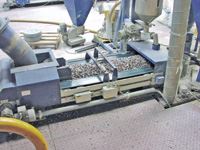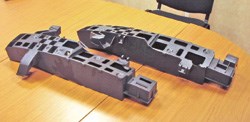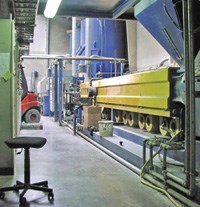How to Turn Auto Shredder Waste Into 60 Million Lb of Plastic Pellets
While much of the world is studying the possibility of getting any economic value out of auto shredder residue—for example, as fuel for cement kilns or power plants—Europe’s second largest scrap-metal reclaimer cranks out polyolefin and polystyrene pellets made from shredder residue at 20,000 to 100,000 lb/hr, or about 40 million lb/yr.Galloo Plastics, the recycling unit of the Galloo Group in Halluin, France, has been so successful at supplying automotive markets with its black PP compounds that it built a second auto shredder residue (ASR) recycling plant this year next to the first, inside its huge scrap yard.
While much of the world is studying the possibility of getting any economic value out of auto shredder residue—for example, as fuel for cement kilns or power plants—Europe’s second largest scrap-metal reclaimer cranks out polyolefin and polystyrene pellets made from shredder residue at 20,000 to 100,000 lb/hr, or about 40 million lb/yr.
Galloo Plastics, the recycling unit of the Galloo Group in Halluin, France, has been so successful at supplying automotive markets with its black PP compounds that it built a second auto shredder residue (ASR) recycling plant this year next to the first, inside its huge scrap yard. The new plant will add around 50% more finished plastics capacity, bringing the total next year to about 60 million lb/yr.
Galloo isn’t the world’s only recycler of ASR. Fifteen minutes away in Ypres, Belgium, Salyp NV uses and its proprietary series of dry-separation technologies (available for licensing) to extract copper, mixed plastics, PUR foam and other materials from ASR (see Learn More box). But Galloo is the only processor taking raw ASR all the way to finished plastics compounds.
Shredder waste contains from 5% to 20% recoverable polymer content. It has to be at least 10% for recycling to be economical, Galloo says. “If you shred only cars, recoverable polymer content will be around 20%,” says Hugues de Feraudy, general manager and part owner of Galloo Plastics and developer of the firm’s separation process.
Galloo’s recycling process currently yields mostly PP compounds, plus some PS and ABS. The process is also capable of extracting PE and can separate talc-filled PP and flame-retardant PS from other PP and PS materials. Galloo plans to add nylon and PVC separation over the next two years.
Galloo Plastics supplies PP compounds for automotive wheel wells, battery cases, and a talc-filled window frame for Peugeot. Black PS waste from discarded electronics and appliances (which also find their way into ASR) go into CD cases, coat hangers, and fasteners for office furniture.
How the process works
Galloo’s process is a proprietary series of existing technologies, modified for ASR, on which Galloo holds four patents with two more pending. However, its wet density separation technology came from Engineering Separation and Recycling (ESR), a U.S. engineering firm with an office in Belgium. Engineering Separation builds high-volume mineral and vegetable sorting equipment and developed a series of dynamic altered-density media drums to separate the main polymer components in ASR (see Keeping Up With Recycling).
Separation starts with the parent company’s metal-reclaiming operation, which grinds the ASR to around 25-mm bits. These go through a large trommel, or rotating cylindrical screen, for classification into a light thermoplastic fraction and heavy thermoset fraction. Next, air classification removes textiles and PUR foam. The remaining thermoplastics and thermoset rubber go through eddy-current separators to remove copper. The thermosets are used by Galloo as fuel.
Galloo then puts the rest of the plastics through a series of four modified ESR dense-media separation drums containing liquids of different densities (1.6, 1.25, 2.2, and 3.2 g/cc). It is a continuous process, similar to that used to remove coal from shale in reclaiming land after strip mining. The first medium (1.6 g/cc) separates organics from inorganics. The second (1.25 g/cc) separates PVC (destined for landfill) from other plastics. The third and fourth media (2.2 and 3.2 g/cc) are used to reclaim valuable metals from a fraction containing engineering plastics like ABS and nylon.
This process concentrates about 90% of the thermoplastics in a fraction constituting 10% of the original mass. Metal recovery pays for the process up to this point, including transportation of the thermoplastic “preconcentrate” to Galloo Plastics, where it goes through a proprietary static dense-media separation. Unlike ESR’s dynamic media separation, with counterflows and rotating cones, static separation uses large (5- to 20-cu-meter) vats in which flakes of different densities float or settle.
This separates materials between 0.9 and 1.5 g/cc density with precision of 0.002 g/cc, Galloo says. Heavy fractions are removed by augers from the bottom, light fractions are skimmed off the top. The vats separate PP from PE and PS, while ABS and talc-filled PP are separated from the remaining plastics of 1.0 to 1.1 g/cc, which are landfilled.
In the final compounding operation, fast-moving conveyors bring a rainbow of colored plastic chips to continuously feed three compounding extruders (two single-screw and a 100-mm Leistritz twin-screw). A 115-mm twin-screw from Clextral in France will be installed in the new plant in December. Galloo developed its own screen changers for the compounding operation. For quality control, Galloo tests its compounds for melt flow, tensile strength, flex modulus, and impact strength.
Other ASR projects
The most recent installation of ESR’s dynamic media separators was in August at Europe’s largest metal shredder, CFF Recycling in Bruyere sur Oise, France. It uses five density-separation drums (vs. four at Galloo), beginning with a plain water medium (1.0 g/cc) to float textiles and foam rubber. Foam is shredded into 2-in. pieces and processed a second time to liberate remaining copper wire. (Galloo uses air classification and eddy currents for this step.)
CFF then uses four dense-media drums similar to Galloo’s (1.6, 1.25, 3.2, and 2.2 g/cc). CFF will use the recovered organics initially as fuel. It hasn’t yet decided whether to pursue plastic compounds.
ESR’s dense-media tanks for ASR separation have also been separating metals from plastics in the U.S. since 1997 at TXI Chaparral Steel in Midlothian, Texas. There is no market currently for the separated plastics in the U.S. because the EPA requires them to be landfilled, owing to potential contamination by PCBs or other toxic chemicals. Chapparal’s goal for the plastic separation is to burn it for fuel in its own cement kiln if it can obtain the necessary environmental permits.
Related Content
The Effects of Temperature
The polymers we work with follow the same principles as the body: the hotter the environment becomes, the less performance we can expect.
Read MoreResin Prices Still Dropping
This downward trajectory is expected to continue, primarily due to slowed demand, lower feedstock costs and adequate-to-ample supplies.
Read MoreThe Importance of Melt & Mold Temperature
Molders should realize how significantly process conditions can influence the final properties of the part.
Read MoreUnderstanding the ‘Science’ of Color
And as with all sciences, there are fundamentals that must be considered to do color right. Here’s a helpful start.
Read MoreRead Next
Troubleshooting Screw and Barrel Wear in Extrusion
Extruder screws and barrels will wear over time. If you are seeing a reduction in specific rate and higher discharge temperatures, wear is the likely culprit.
Read MoreLead the Conversation, Change the Conversation
Coverage of single-use plastics can be both misleading and demoralizing. Here are 10 tips for changing the perception of the plastics industry at your company and in your community.
Read More












